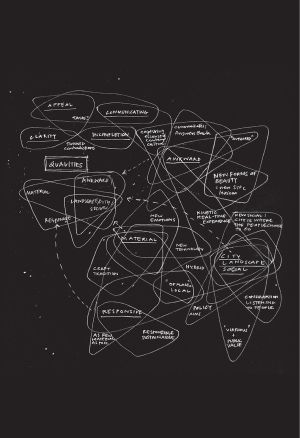Orbits and Trajectories: Why Architecture Must Never Stand Still
Orbits and Trajectories best describes the nature of the relationships that underscore the overarching findings in my PhD, and individual discoveries within it. As “Orbit Diagrams” they offer a non-linear, spatial way to navigate issues and mutual encounters. They help to explain how actions coalesce to become acts of authorship – and how this operates within a creative, collaborative practice.
This sense of push-pull is also embodied in the architecture that DSDHA makes and which, for the purpose of this study, has been termed ‘awkward’. In the past it has been described by others as “dynamic instability”. We now confidently consider this quality to be a new form of beauty. It is designed to create a response, to be responsive, and to engage the wider world with architecture.
When we speak of beauty here, it is not in the usual manner of acknowledged design systems that assess how well a design conforms to set rules. Our search is for a ‘New Beauty’: there are no fixed proportional or material systems at play; there is no pattern book or set of principles to follow.
Instead, our new idea of beauty is defined by an emergent aesthetic enquiry. Its qualities are about demonstrating certain attributes of the work through the work. New Beauty is active, rather than passive and is about creating work that allows the viewer to see it in a way that causes them to feel slightly interrogated, or provoked. The New Beauty that we are seeking creates a situation where the subject – the architecture – is actually answering back and raising questions in the viewer’s mind. This active mode of reception brings with it a kind of delight or moment of illumination for the viewer, even if this response occurs after an initial sense of confusion or feeling perplexed.
The immediate sense of awkwardness or confusion can be created through a range of architectural choices. It can be based on a cultural disjuncture – for example, a place or building that challenges one’s preconceptions of what occurs inside it.

Orbits and Trajectories is the product of Deborah Saunt’s PhD with RMIT University’s Practice Research Programme. RMIT’s programme redefines the structure of conventional doctorates by encouraging researchers to bring critical focus to their own creative practices as the primary source of their PhD.
Using her experience of working as an architect and founding DSDHA to inform the research, Deborah’s PhD thesis observes how her creative practice operates both individually and collaboratively, ultimately demonstrating the ‘dynamic instability’ of architecture as an iterative process of spatial thinking and critical reflection.
This piece of research has been influential in the evolution of DSDHA’s practice methodology, reshaping our internal design processes and the way we describe our role as spatial strategists—not just architects or urban designers, but active participants in shaping civic life and cultural meaning through architecture.